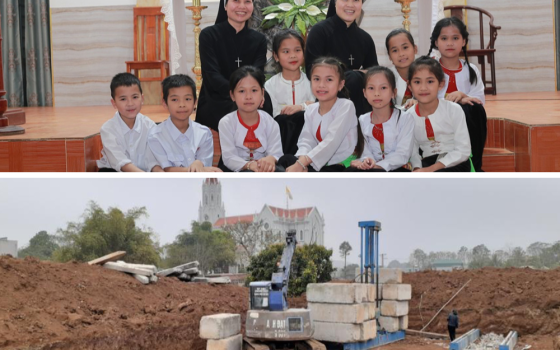
While a visit from the Roman inquisition might intimidate most of us, the timing couldn’t be better for American communities of religious women. They have nothing to hide and a marvelous story to tell, unknown to many Catholics and far richer than the caricatures Hollywood and nostalgia have created.
Visitors (Roman and other) to the estimated 400 motherhouses across the country will take away their own impressions, but two things are bound to stand out. One is the community cemetery whose hundreds of ordered graves hold the stories of the first women sent by their European foundations to the frontiers of the new nation, and then those successive waves of sisters inspired to follow them in mission. The story is told a second time in the faces of the mothers superior of each community that stare back at visitors from portraits -- painted, tintype, black and white, and color photo -- hung along the corridors of central administration buildings.
The thousands of sisters they sent like laborers to the harvest helped build the church in America, staffing schools, hospitals and orphanages, starting ministries wherever need presented itself, in the cities teeming with new immigrants, on the frontiers where sisters arrived hauling harps and pianos to educate the daughters of farmers, or on the battlefields of the Civil War, nursing the wounded on both sides, or through earthquake and plague in California, to earn a place of respect in an otherwise hostile, anti-Catholic America. This history is eloquently told by a two-year traveling exhibit (“Women and Spirit,” NCR Feb. 17, 2009) that the visitors will not want to miss.
In the boom years of the 20th century, convents and monasteries swelled with the daughters of immigrants, responding in faith and to the chance to be professionally educated, to travel and serve at a time when the proscribed roles for women were to marry and/or find careers as teachers, nurses and secretaries. As liberation movements swept the globe in the ’60s, sisters expanded their reach into the civil rights and peace movements, poverty and prison ministry, with thousands more sent to serve throughout the developing world as missionaries.
In an atmosphere of greater freedom and opportunity for women as a whole, many sisters also left their communities but not their vocations and extended the charisms and professional skills they had gained into every area of commerce, politics, public education and social service.
Today, some 59,000 religious women, aging but active, continue to serve the church. Communities have explored new forms of outreach through associate and volunteer programs and have formed strong ecumenical ties for common ground justice efforts.
The Vatican probe into their life will take two years. Billed as a friendly visit, it nonetheless parallels an investigation into the orthodoxy and loyalty of the Leadership Conference of Women Religious, which represents 95 percent of all American sisters. Whatever the Vatican expects to learn, this much is already well known:
- American women religious faithfully carried out the mandates of the Second Vatican Council to re-examine and adapt their original charisms in the light of current challenges. They embraced real change and forged ahead at great effort and cost, often when many bishops and pastors held back or opposed the renewal.
- They accepted the council’s call for collegiality by shifting from top-down to consensus-style governance in their communities, gaining valuable communication skills and management practices they then shared with the diocesan offices and parishes where they served.
As important as any official directive, the sisters’ example and encouragement facilitated a culture of participation and increased lay ownership in the church. They helped many priests deepen their personal and pastoral skills, and they helped mentor thousands of lay ministers -- men and women -- into team ministry.
- They modeled person-centered pastoral approaches that welcomed first and judged less, thus fostering a church whose image was appropriately domesticated and feminized to be “mother church.” Even as the formal church debates doctrinal and canonical complexities, women religious continue to lead the way in practicing the primacy of Gospel love.
- After Vatican II, women religious entered every field of pastoral, historical and biblical theology and were soon leading many of its national associations and were prominent in publishing and teaching. Their scholarship has challenged conventional assumptions and explored new horizons, helping to midwife the church promised by Vatican II.
Thus, at a time when the American church as a whole has been hurt by scandal, financial crisis, a severe priest shortage and, some say, a serious paralysis of hierarchical leadership, the sisters’ story is worth telling and celebrating. The timing could not be better.
[This editorial appears in the June 12 issue of National Catholic Reporter.]


